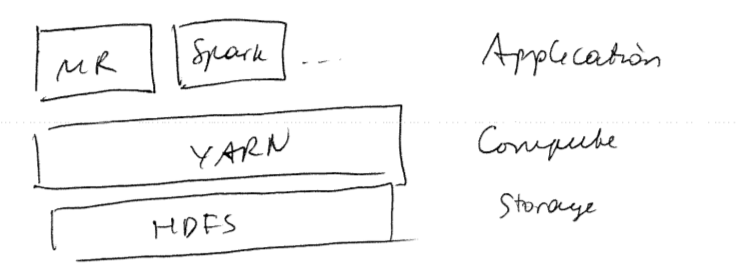YARN
YARN stands for “Yet another resource negotiator”
- it’s a Hadoop cluster resource manager system
- it’s not restricted to Hadoop MapReduce and can run any systems, e.g. Flink
- it’s an alternative to Hadoop TaskTracker - which is referred as “Hadoop1”
- YARN is “Hadoop2”
YARN
- so YARN is API for requesting and working with cluster resources
- it’s for frameworks, not for users
Components
 It has:
It has:
- Resource Manager: one per cluster
- Node Managers: per each node
Roles of components:
- node managers launch and monitor containers (which are unix processes)
- a client contacts the RM and asks to run a ‘‘master process’’
- if the requirements can be satisfied, YARN finds a node manager that can run it
- then the application master can request more containers for its processes
a resource request in YARN is a set of constraints that include:
- memory constrain: how much memory should a container have
- CPU: how much cores
- locality constant: container should be as close to data as possible
Job Execution
How a Job is Executed
- Let us consider how YARN executes a Hadoop MapReduce job
 There are 5 entities
There are 5 entities- client - submits the job
- YARN Resource Manager - coordinates allocation of resources
- YARN Node Manager - launches and monitors containers on the machines of the cluster
- MR Application Master - coordinates the tasks that run the MR job
- MR tasks and the Application Master run the container scheduled by the Resource anager
- it is managed by the Node Manager
- HDFS for sharing job files
Job Submission
The client submits the job
- typically done via
job.waitForCompletion(true) - the client also pulls the job’s execution status and progress each second and reports to the user
Job Submission:
- asks the Resource Manager for a new application id - it will used as the MR Job id
- checks out the specification of the job
- computes the input splits
- copies the job resources: jars, config, computed input split
- submits the job
Job Initialization
- when the Resource Manager get a call to its
submit, it passes it to YARN Scheduler - The Scheduler allocates a container that satisfies the requirements
- the Resource Manager launches the Application Master process there
- For MapReduce, the Application Master is
MRAppMasterclass - it creates some bookkeeping classes to monitor the progress - Then it retrieves the input splits from HDFS
- and creates map tasks for each split and reducer tasks (set with
setNumReduceTasks()) - each task is assigned an ID
Task Assignment
- the Application Master request containers for all map and reduce tasks from the Resource Manager
- first, the requests are made for the map tasks
- requests for reducers aren’t made until at least 5% of all map tasks are finished
Request constraints that Resource Manager has to satisfy:
- Locality constraint. Optimal case when the task is ‘‘data local’’, or at least ‘‘rack local’’
- Memory and CPU requirements. By default, each task is allocated 1024 MB and 1 CPU
These values are configurable on per-job basis:
mapreduce.map.memory.mbmapreduce.reduce.memry.mbmapreduce.map.cpu.vcoresmapreduce.reduce.cpu.vcores-
they are subject to min/max constraints specified in the YARN config ()
Task Execution
- a task is assigned to a container on a particular node by the Resource Manager’s Scheduler
- the Application Manager starts the container by contacting the node manager
- the task is executed by a java class
YarnChild - before running, it get all needed files (e.g. config, job jars, etc) from the distributed cache
- finally, it runs the tasks: first, map tasks, then - reduce tasks
YarnChildruns on a separate JVM so it doesn’t affect anything else
Job Completion
- When the last Job task is complete, the Application Master changes its status to “SUCCESSFUL”
- then
job.waitForCompletion(true)finishes and returnstrue - if there was an error, it returns
false